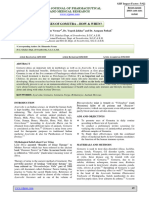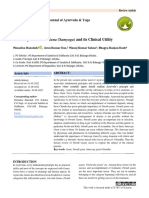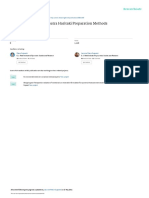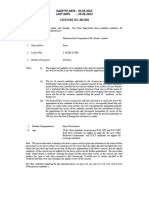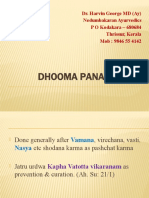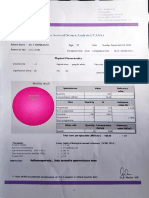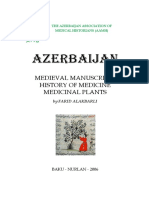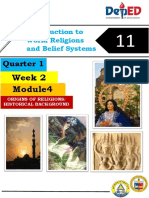A Retrospective Study: Concept of Bhasmikarana: World Journal of Pharmacy and Pharmaceutical Sciences
A Retrospective Study: Concept of Bhasmikarana: World Journal of Pharmacy and Pharmaceutical Sciences
Uploaded by
Rahul KirkOriginal Description:
Original Title
Copyright
Available Formats
Share this document
Did you find this document useful?
Is this content inappropriate?
Report this DocumentCopyright:
Available Formats
A Retrospective Study: Concept of Bhasmikarana: World Journal of Pharmacy and Pharmaceutical Sciences
A Retrospective Study: Concept of Bhasmikarana: World Journal of Pharmacy and Pharmaceutical Sciences
Uploaded by
Rahul KirkCopyright:
Available Formats
WORLD JOURNAL OF PHARMACY AND PHARMACEUTICAL SCIENCES
Murulidhar et al. World Journal of Pharmacy and Pharmaceutical Sciences
SJIF Impact Factor 7.421
Volume 7, Issue 10, 735-740 Review Article ISSN 2278 – 4357
A RETROSPECTIVE STUDY: CONCEPT OF BHASMIKARANA
Dr. Murulidhar N.*1 and Dr. Mohan Kumar B. N.2
1
Assosciate Professor, Dept. of Agada Tantra, AAMC, H & R.C, D. B. Pura, Bangaluru,
India.
2
Principal, Proff. & H.O.D, Dept. of Rasashastra & Bhaishajya Kalpana, AAMC, H & R.C,
D.B. Pura, Bengaluru, India.
ABSTRACT
Article Received on
05 August 2018, Rasashastra is an ancient Pharmaceutical science developed in an
Revised on 25 August 2018,
Accepted on 15 Sept. 2018
Indian soil probably during 7th Century A.D with a noble thought to
DOI: 10.20959/wjpps201810-12448 achieve Emancipation. To achieve this primary motto initially ancient
seers experimented tremendously on Parada i.e. Mercury with wide
range of herbal drugs. By this study they have drawn a conclusion that
*Corresponding Author
Dr. Murulidhar N. the processed Mercury would be very effective. With this positive
Assosciate Professor, Dept. result eventually these scholars explained various formulations like
of Agada Tantra, AAMC, H Khalvirasayana, Kupipakwarasayana, Parpatirasayana, Pottalirasayana,
& R.C, D. B. Pura,
Bhasma, Pishti, Satvapatana, etc. Bhasma has been proven clinically
Bangaluru, India.
for its efficacy over the various ailments. In this regard even the
prominent texts of Ayurveda like Charaka Samhita, Sushruta Samhita & Ashtanga Hrudaya
have thrown a light in their treatment section. Eventually it got developed & modified during
medieval period. The authors of this science Rasavaghbhata, Somadeva, Sharangadhara,
Yashodharabhatta, Shreeshanandasharma, etc have emphasized immensly on this. Hence the
present study has been taken up to review the process of Bhasma.
KEYWORDS: Bhasma, Parada, Charaka, Sushruta, etc.
INTRODUCTION
Rasashastra is an ancient Pharmaceutical science known to Indians since thousands of years
ago. Probably it came into existence during medieval period i.e. 7th Century A.D with an
intention to remove poverty and to eradicate completely human illnesses. However the
ultimate goal of this science is to achieve Salvation. This could be possible only by means of
healthy body. To achieve this goal the ancient seers came out with two important principles
www.wjpps.com Vol 7, Issue 10, 2018. 735
Murulidhar et al. World Journal of Pharmacy and Pharmaceutical Sciences
they were Lohaveha & Dehavedha. Initially the scholars experimented rigorously on Parada
i.e. Mercury with wide range of prescribed herbal drugs. After keen observation and constant
hard work they had drawn a conclusion that if processed Mercury could transform lower
metal into higher metal like Gold, then it would be very effective on human ailments also. As
a resultant of this experiment they contributed huge number of medicinal preparations like
Khalvirasayana, Kupipakwarasayana, Parpatirasayana, Pottalirasayana, Bhasma, Pishti,
Satvapatana, etc. Bhasma is one such preparation processed with prescribed herbal drugs and
exposed to appropriate amount of fire. For various scientific reasons Bhasma has gained its
importance in the field of Ayurvedic medical science. Those are physically very minute, for
lightness, quick action, easy bio-availability, tastelessness, etc. Hence it may exhibit effective
Pharmacological action.
History
Earlier to this Pharmaceutical science, the various literatures have contributed the
methodology of medicinal preparations. Prominently Charaka Samhita, Sushruta Samhita &
Ashtanga Sangraha. These texts have revealed so many preparations like Swarasa, Kalka,
Shruta, Hima, Phanta, Lehya, Ayaskriti, etc. Ayaskriti is one such medicinal preparation
where chiefly metal is being used in Charaka Chikitsa Sthana[2] – 1/3/15-20(Rejuvenation),
Sushruta Chikitsa Sthana[4] – 10/11(Mahakushta – Skin disorder) & Ashtanga Hrudaya
Chikitsa Sthana[3] 12/28-32 (Prameha Chikitsa) respectively. Eventually the Rasashastra took
birth with a noble thought to achieve Salvation by means of healthy body and underwent lot
of modification in Pharmaceutical process. For various scientific reasons the metallic
medicines became a significant part of ayurveda.
Definition of Marana
Initially the Metals & Minerals must undergo for Purification with prescribed herbal juice or
with decoction for a stipulated time. Then it should be treated with appropriate amount of
fire. This process has to be repeated till we get appropriate Bhasma lakshana. This process is
known as Marana.[1]
Definition of Puta
Puta indicates the quantum of heat provided to Rasa, Maharasa, Uparasa, Sadharanarasa,
Dhatu, Upadhatu, Ratna, Uparatna etc during the agni samskara. It should not be too high or
too low during the process and the optimum temperature must be provided. The properly
prepared bhasma may not cause harmful effect & will be fit for therapeutic purpose.[5]
www.wjpps.com Vol 7, Issue 10, 2018. 736
Murulidhar et al. World Journal of Pharmacy and Pharmaceutical Sciences
Necessity & Significance of Puta in Bhasmikarana
As we know that the unprocessed Rasoushadhis are not suitable for therapeutic
administration. So to overcome this this the ancient Rasavaidyas have focused tremendously
over the agnisamskara and cautioned us heavily not to administer the same. If so it may cause
deleterious effect over the body. By keeping this in mind they have clearly explained that,
drug has to be treated with fire till it attains Bhasma lakshana, Rasayana, Vajikarana, etc.
Benefits of Puta.[5] Those are as follows:
1. It enhances therapeutic properties.
2. It will become so light for digestion, hence it facilitates effective rate of absorption.
3. Effectively stimulates digestive enzymes.
4. Attains Bhasma lakshanas like Vaaritara & Rekhapurna.
Classification of Puta
Puta has been classified based on various factors like the sources, intensity and type of the
fuel and equipment’s used in the process. They are as follows:
PUTA
(Source) (Intensity) (Fuel & Equipment)
Chandra puta Mahaputa Gorvara puta
Surya puta Gajaputa Bhanda puta
Agni puta Kukkutaputa Baluka puta
Varahaputa
Laghuputa
Bhudhara puta
General Requirements
Sl No Names Sl No Names Sl No Names Sl No Names
Different Puta – Mahaputa,
1 3 Cloth 5 Water 7 Spoon
Gajaputa, Varahaputa etc.
2 Mud plates - Sharavas 4 Multhani 6 Khalva Yantra
Samanya Puta karma
www.wjpps.com Vol 7, Issue 10, 2018. 737
Murulidhar et al. World Journal of Pharmacy and Pharmaceutical Sciences
Based on its specific characteristics & as per classics it is mandatory to undergo
Rasoushadhis for purification process initially like Bhavana, Nirvapa, Dhalana with wide
range of herbal drugs. Then it has to be grinded for some time either with prescribed herbal
juice or with decoction. When it attains semisolid consistency, even size of pellets are
prepared and dried under sunshade. Later with the help of wet smeared mud cloth they are
enclosed in suitable size of strong mud plates. This process has to be repeated till we get
appropriate bhasma lakshana. The following photos will illustrate.
1 Jaggery with Mica 2 Eranda Leaf Juice -Grinding With Mica
3 Before Igniting Process – Pellets of Mica
4 Exposing To Fire 5 After Incineration
General Steps of Incineration (Example: Abhraka Bhasma)
DISCUSSION
As a known fact that the Metals & Minerals are not suitable for therapeutic administration.
Hence it requires to undergo for various processes like Shodhana, Marana, Pishti,
Satvapatana, etc. Bhasma is the outcome of Marana process. The important texts of Ayurveda
have emphasized immensely on this. In Charaka Charaka Samhita, Sushruta Samhita &
www.wjpps.com Vol 7, Issue 10, 2018. 738
Murulidhar et al. World Journal of Pharmacy and Pharmaceutical Sciences
Ashtanga Hrudaya and they have indicated in Rasayana, Mahakushta & Prameha chikitsa
respectively. These authors have addressed Raja, Churna as Bhasma. Eventually it got
developed and modified moderately during medieval period. I.e. 7th Century AD. Whereas in
Samhita period, Teekshna loha patra has to be heated immensely and quenched in Triphala
Kashaya, Go-mutra, Kshara jala, etc. This process has to be repeated till it turns powder form.
Here we may not find any Bhasma lakshanas. Eventually the Rasavaidyas have strictly
recommended that any Rasoushadhi initially must need to undergo purification and then
incineration. Also they have explained Bhasma lakshanas for each drug. These things we may
not find in earlier texts. For safe & better efficacy it is extremely mandatory to pass the
following tests. Those are as follows.[1] In Apunarbhava Bhasma pareeksha the test is being
done by triturating required quantity of bhasma with Mitra panchaka varga (Gunja, Guda,
Guggulu, Tankana & Madhu). Later when the mixture is placed in a crucible and subjected
for intense heat and no changes in its quality & quantity is observed, and then it clearly
indicates that bhasma process is proper. The Rationality behind, the original characters of
metals are malleability, ductility, hardness, luster etc. These properties are likely to lose after
bhasmikarana. If these properties present even after incineration then it shows the process is
not completed. In Vaaritara test the Pinch of bhasma is taken and gently dropped from the
closed distance over the undisturbed surface water and if it floats, confirms the completion of
bhasma process the completion of Bhasma process. In Uttama pareeksha a pinch of bhasma is
dropped gently from the closed distance over undisturbed water surface. Later 2 to 3 grains
are placed gently over the bhasma. Even then it floats; it indicates the fineness & lightness of
the bhasma. The purpose of these test is to determine its lightness. If the drug is light in its
weight, it may facilitate bio-availability & enhance rate of penetration. In Rekhapurna
pareeksha a pinch of bhasma is taken in between thumb and index finger, pressed gently and
observed carefully. If it enters in between the minute finger lines, it confirms the completion
of process. The intention of this test is to decide its sheerness. The sheerness property can
penetrate even at the deepest level. Thus it may exhibit appropriate action. In Niruttha
pareeksha the required quantity of bhasma has to be taken in crucible along with Silver foil
and subjected to heat. The test is being carried out to determine its metallic properties. After
the process one should see that that the bhasma particle should not stick to the surface of
Silver foil. If it happens, then it clearly indicates the presence of metallic properties and may
not fit for therapeutic administration. In Niswadu pareeksha It is a simple test in which a
pinch of Bhasma has to be tasted and observed for avyakta rasa. The idea of conducting this
test, the metals & minerals loses all its properties and hence it may not possess any taste.
www.wjpps.com Vol 7, Issue 10, 2018. 739
Murulidhar et al. World Journal of Pharmacy and Pharmaceutical Sciences
CONCLUSION
Bhasmikarana is a process in which immense therapeutic properties will be enhanced. Due to
its minute particle size it may facilitate fast action and provide maximum bio-availability.
Lesser dosage may sufficient during treatment. Bhasmapareekshas may ensure the
completion of process.
REFERENCES
1. Shri Sadananda Sharma, Rasatarangini, Delhi: Motilal Banarasidas, 2009.
2. Prof. Priyarat Sharma, Charaka Samhita, Varanasi: Chaukhambha Orientalia, 2008.
3. Prof. K.R. Srikantha Murthy, Ashtanga Hrdayam, Varanasi: Chaukhambha Krishnadas
Academy, 2003.
4. Prof. K.R. Srikantha Murthy, Illustrated Sushruta samhita, Varanasi: Chaukhambha
Orientalia, 2016.
5. Dr. Indradev Tripathi, Rasaratnasamuchchaya, Varanasi: Chaukhambha Sanskrit
Sansthan, 2009.
www.wjpps.com Vol 7, Issue 10, 2018. 740
You might also like
- Magic Witchcraft and Religion An Anthropological Study of The SupernaturalDocument580 pagesMagic Witchcraft and Religion An Anthropological Study of The SupernaturalMauricio Lustosa100% (7)
- Dokmar Ship Knowledge A Modern Encyclopedia by K. Van DokkumDocument340 pagesDokmar Ship Knowledge A Modern Encyclopedia by K. Van Dokkumamin_corporation50% (4)
- Rasashastra - Eng. - BookDocument83 pagesRasashastra - Eng. - BookN Rajkala nagarajanNo ratings yet
- The University of New Hampshire Interoperability Laboratory Introduction To Pcie ExpressDocument20 pagesThe University of New Hampshire Interoperability Laboratory Introduction To Pcie Expressshyamsundar100% (1)
- Movie Review - AnukulDocument1 pageMovie Review - AnukulNehas22No ratings yet
- Shodhana ConceptDocument7 pagesShodhana ConceptLalchand SahuNo ratings yet
- Pharmaceutical Study On Gandhak Druti: A Review ArticleDocument5 pagesPharmaceutical Study On Gandhak Druti: A Review ArticleHinal AmbasanaNo ratings yet
- Importance of Arshoghna Mahakashaya of Charaka Samhita: A ReviewDocument10 pagesImportance of Arshoghna Mahakashaya of Charaka Samhita: A Reviewpokeman693No ratings yet
- Clinical Application of Shadvidhopkrama A CriticalDocument6 pagesClinical Application of Shadvidhopkrama A CriticalBhonsle AmayNo ratings yet
- Article 1582952806Document2 pagesArticle 1582952806siddhartha.mohapatra9579No ratings yet
- European Journal of Biomedical AND Pharmaceutical SciencesDocument2 pagesEuropean Journal of Biomedical AND Pharmaceutical SciencesRavi SharmaNo ratings yet
- Six UpakramaDocument5 pagesSix UpakramaAman TyagiNo ratings yet
- Ahara Kalpana in Charaka Samhita - A Critical ReviewDocument9 pagesAhara Kalpana in Charaka Samhita - A Critical ReviewCarlosNo ratings yet
- A Review On The Uniqueness of Rasayana Adhikara of Rasaratna Samuchchaya PDFDocument4 pagesA Review On The Uniqueness of Rasayana Adhikara of Rasaratna Samuchchaya PDFsudha C RNo ratings yet
- Kakmachi Review AyurpharmDocument12 pagesKakmachi Review Ayurpharmtanwyee28No ratings yet
- 83-Article Text-253-1-10-20151213Document9 pages83-Article Text-253-1-10-20151213KumarNo ratings yet
- Article WJPR 1490956558Document11 pagesArticle WJPR 1490956558Rudra RoyNo ratings yet
- A Review On Different Methods of Bhallataka Shodhana W.S.R. To Rasa Tantra Saar & Siddha Prayog SangrahDocument5 pagesA Review On Different Methods of Bhallataka Shodhana W.S.R. To Rasa Tantra Saar & Siddha Prayog Sangrahsudha C R0% (1)
- JREIMMineralsin CSDocument13 pagesJREIMMineralsin CSvinit sharmaNo ratings yet
- A Pharmaceutical Review Study of Shweta Parpati On: MutrakrichraDocument7 pagesA Pharmaceutical Review Study of Shweta Parpati On: MutrakrichraShivani SheteNo ratings yet
- Article Wjpps 1509443667Document13 pagesArticle Wjpps 1509443667SadernNo ratings yet
- Ahara Kalpana PDFDocument9 pagesAhara Kalpana PDFvipra ayurvedaNo ratings yet
- Ahara Kalpana PDFDocument9 pagesAhara Kalpana PDFvipra ayurvedaNo ratings yet
- IJRAPP3Document3 pagesIJRAPP3roshan.mNo ratings yet
- 03 A025 5123Document13 pages03 A025 5123Sri HariNo ratings yet
- A Preparation and Pharmaceutical Review of Makkaya Paneeya KsharaDocument7 pagesA Preparation and Pharmaceutical Review of Makkaya Paneeya KsharaGuna SoundariNo ratings yet
- Shatapushpa Taila An Ayurvedic Formulation For Menstrual ProblemsDocument7 pagesShatapushpa Taila An Ayurvedic Formulation For Menstrual ProblemsNickOoPandeyNo ratings yet
- Purana Ghrita and Its Therapeutic Implications in Neuropsychiatric DisordersDocument3 pagesPurana Ghrita and Its Therapeutic Implications in Neuropsychiatric DisordersEditor IJTSRDNo ratings yet
- Ayurpharm 35Document11 pagesAyurpharm 35jaya2504No ratings yet
- Article Wjpps 1475213708Document29 pagesArticle Wjpps 1475213708Vaidya NurNo ratings yet
- A Therapeutic Potential - Manahshila (Realgar) : Dr. Jyoti Sonkar and Dr. Dev Nath Singh GautamDocument16 pagesA Therapeutic Potential - Manahshila (Realgar) : Dr. Jyoti Sonkar and Dr. Dev Nath Singh Gautamashutosh tiwariNo ratings yet
- A Critical Review On Historical Aspects of KsharaDocument7 pagesA Critical Review On Historical Aspects of KsharaRaghuram KurojuNo ratings yet
- 1445-Article Text-2929-1-10-20211107Document8 pages1445-Article Text-2929-1-10-20211107Saarthak SinghNo ratings yet
- Therapeutic Uses of Vanga Bhasma A Criti PDFDocument5 pagesTherapeutic Uses of Vanga Bhasma A Criti PDFMSKCNo ratings yet
- Rejuvination BakuchiDocument12 pagesRejuvination BakuchiAmbesh jhaNo ratings yet
- Shad Dharan YogDocument10 pagesShad Dharan YogSanita Anjayya EppalpalliNo ratings yet
- 1220 PDFDocument4 pages1220 PDFSwagath NNo ratings yet
- Anti-Fungal 5Document5 pagesAnti-Fungal 5shubham panditNo ratings yet
- Critical Review of Shaddharana Yoga: A Polyherbal FormulationDocument9 pagesCritical Review of Shaddharana Yoga: A Polyherbal FormulationChakradhar DNo ratings yet
- Use of Trina Dhanya According To Aahara Vidhi VishDocument4 pagesUse of Trina Dhanya According To Aahara Vidhi Vishumapati 1505No ratings yet
- Critical Review of Dietetics in AyurvedaDocument14 pagesCritical Review of Dietetics in AyurvedakavalapparaNo ratings yet
- A Critical Review On Brihat Kasturi Bhairav Rasa With Special Reference in Management of Jwara A Herbomineral FormulationDocument8 pagesA Critical Review On Brihat Kasturi Bhairav Rasa With Special Reference in Management of Jwara A Herbomineral FormulationEditor IJTSRDNo ratings yet
- The Effect of Takrarishta On Grahaniroga: Vidya G. Honde, Rajesh Ingole and Piyush GandhiDocument11 pagesThe Effect of Takrarishta On Grahaniroga: Vidya G. Honde, Rajesh Ingole and Piyush GandhiSuresh RidetsNo ratings yet
- Average Energy ContractsDocument14 pagesAverage Energy Contractsjw7hnj26gcNo ratings yet
- 13 Epra+Journals+10182Document4 pages13 Epra+Journals+10182Divya SharadNo ratings yet
- Journal On Threpetical Study On MutraDocument6 pagesJournal On Threpetical Study On MutraVijay DawarNo ratings yet
- PUNARNAVA MiracleDocument5 pagesPUNARNAVA MiracleAlluNo ratings yet
- A Concept of Paradi Guna (Samyoga) and Its Clinical UtilityDocument5 pagesA Concept of Paradi Guna (Samyoga) and Its Clinical UtilityAnjali SolankiNo ratings yet
- Significance of Puta in Bhasmikarana With SpecialDocument4 pagesSignificance of Puta in Bhasmikarana With SpecialRahul KirkNo ratings yet
- Pandu Anaemia An Ayurvedic Literature ReviewDocument7 pagesPandu Anaemia An Ayurvedic Literature ReviewAmith G R AnajiNo ratings yet
- Swasthavritta Syllabus: SL No Topic Domain TimeDocument25 pagesSwasthavritta Syllabus: SL No Topic Domain TimeJyotiranjan MeherNo ratings yet
- The Role of Patolakaturohinyadi Kashaya in UdardaDocument3 pagesThe Role of Patolakaturohinyadi Kashaya in UdardaEditor IJTSRDNo ratings yet
- Katigraha by Harshada NimhanDocument18 pagesKatigraha by Harshada NimhanharshadaNo ratings yet
- A Review On Therapeutic Indication of Yashtimadhu Glycerrhiza Glabra Linn W.S.R. To Charaka SamhitaDocument7 pagesA Review On Therapeutic Indication of Yashtimadhu Glycerrhiza Glabra Linn W.S.R. To Charaka SamhitaEditor IJTSRDNo ratings yet
- 10.single Drug Therapy in Ardhavabhedaka With Special Reference To Migraine - A Review PDFDocument5 pages10.single Drug Therapy in Ardhavabhedaka With Special Reference To Migraine - A Review PDFk2kkhanna105No ratings yet
- 2 IjahmDocument15 pages2 IjahmSwagath N100% (1)
- Kamala-An Ayurvedic Perspective: Volume 8, Issue 8, 409-422. Review Article ISSN 2277 - 7105Document14 pagesKamala-An Ayurvedic Perspective: Volume 8, Issue 8, 409-422. Review Article ISSN 2277 - 7105SanjanaNo ratings yet
- Gomutra HaritakiDocument3 pagesGomutra HaritakibiaravankNo ratings yet
- Critical+Analysis+of+Gurvadi+Guna+According+to+Hemadri +a+Review+Article+ +copy+ +Document7 pagesCritical+Analysis+of+Gurvadi+Guna+According+to+Hemadri +a+Review+Article+ +copy+ +seth.mahesh657No ratings yet
- Arogyavardhini Vati AtheoriticalanalysisDocument4 pagesArogyavardhini Vati AtheoriticalanalysisKinjal SharmaNo ratings yet
- Kshara PDFDocument8 pagesKshara PDFVineet NavrangNo ratings yet
- Article Wjpps 1530609494Document7 pagesArticle Wjpps 1530609494Vijaya DwarampudiNo ratings yet
- A Handbook On Ayurvedic Intranasal Drug Therapy: Nasya Karma ChikitsaFrom EverandA Handbook On Ayurvedic Intranasal Drug Therapy: Nasya Karma ChikitsaRating: 3.5 out of 5 stars3.5/5 (3)
- Ayurveda DictionaryDocument68 pagesAyurveda DictionaryRahul KirkNo ratings yet
- AMETROPIADocument48 pagesAMETROPIARahul KirkNo ratings yet
- SDK Essay CompetitionDocument1 pageSDK Essay CompetitionRahul KirkNo ratings yet
- Syllabus FOR: AIAPGET 2023Document5 pagesSyllabus FOR: AIAPGET 2023Rahul KirkNo ratings yet
- Health Checkup BrochureDocument4 pagesHealth Checkup BrochureRahul KirkNo ratings yet
- Emergency ManagementDocument9 pagesEmergency ManagementRahul KirkNo ratings yet
- Noti 61 23Document3 pagesNoti 61 23Rahul KirkNo ratings yet
- s13312 023 2898 XDocument1 pages13312 023 2898 XRahul KirkNo ratings yet
- Frozen Shoulder Rehabilitation ExercisesDocument2 pagesFrozen Shoulder Rehabilitation ExercisesRahul KirkNo ratings yet
- Vasaguloochyadi Kashayam - YogamruthamDocument5 pagesVasaguloochyadi Kashayam - YogamruthamRahul KirkNo ratings yet
- Clinical 20case 20reports 20 - 202022 20 - 20narayanDocument6 pagesClinical 20case 20reports 20 - 202022 20 - 20narayanRahul KirkNo ratings yet
- Yogamrutham - Aviltholadi BhasmamDocument6 pagesYogamrutham - Aviltholadi BhasmamRahul KirkNo ratings yet
- 7 DhumapanaDocument21 pages7 DhumapanaRahul Kirk100% (1)
- Diabetes Mellitus Aticle ApthaDocument6 pagesDiabetes Mellitus Aticle ApthaRahul KirkNo ratings yet
- Lakshmanarishtam - YogamruthamDocument6 pagesLakshmanarishtam - YogamruthamRahul KirkNo ratings yet
- Shihabudheen P - 178613Document3 pagesShihabudheen P - 178613Rahul KirkNo ratings yet
- Manikanth T Medical Reports OldDocument4 pagesManikanth T Medical Reports OldRahul KirkNo ratings yet
- Cerebellum Gross Appearance of The Cerebellum: Posterior Lobe), Which Is TheDocument10 pagesCerebellum Gross Appearance of The Cerebellum: Posterior Lobe), Which Is TheRafu DestajoNo ratings yet
- The Unresolved Conflict Between Ray Stantz and The Blowjob GhostDocument5 pagesThe Unresolved Conflict Between Ray Stantz and The Blowjob GhostAlexander KennyNo ratings yet
- IT - NY - 02b - Worksheet On Reading Comprehension - AKDocument3 pagesIT - NY - 02b - Worksheet On Reading Comprehension - AKperictNo ratings yet
- Medieval Manuscripts PDFDocument126 pagesMedieval Manuscripts PDFEmil Jivishov0% (1)
- WTS ProposalDocument38 pagesWTS ProposalAnh Thu MaiNo ratings yet
- Space Infections PDFDocument98 pagesSpace Infections PDFRamya ReddyNo ratings yet
- TaskingDocument2 pagesTaskingAleezah Gertrude Raymundo0% (1)
- Epidemiology of Periodontal DiseaseDocument24 pagesEpidemiology of Periodontal DiseaseAsad Khan5556No ratings yet
- Iwrbs11 - Q1 - M4Document11 pagesIwrbs11 - Q1 - M4Margareth DautNo ratings yet
- Ebook Download (Ebook PDF) Principles of Public Speaking 19th Edition All ChapterDocument43 pagesEbook Download (Ebook PDF) Principles of Public Speaking 19th Edition All Chapterfumanomajnu100% (11)
- Stative VerbsDocument4 pagesStative VerbsJesi GonzalezNo ratings yet
- Shirdi Saibaba Morning ArathiDocument13 pagesShirdi Saibaba Morning ArathihellosuNo ratings yet
- A Missing Cat. (A/an/the - Articles Review) Complete With The A/an/theDocument2 pagesA Missing Cat. (A/an/the - Articles Review) Complete With The A/an/theJorge Eliecer CardonaNo ratings yet
- CVDocument3 pagesCVJax Roxanne GmNo ratings yet
- Annex 2 Basic Education Enrolment Form DO 3 2018Document6 pagesAnnex 2 Basic Education Enrolment Form DO 3 2018Eric John Vegafria100% (1)
- ISMT12 - Day 112 - Fardhian - Physical and Neurologic ExaminationDocument26 pagesISMT12 - Day 112 - Fardhian - Physical and Neurologic Examinationbosnia agusNo ratings yet
- The Creative Act, 1957Document3 pagesThe Creative Act, 1957Mattia CapellettiNo ratings yet
- English Language Paper 1 Revision: TH THDocument19 pagesEnglish Language Paper 1 Revision: TH THnellytusiimeNo ratings yet
- Multicultural Literature Evaluation PDFDocument4 pagesMulticultural Literature Evaluation PDFapi-449676305No ratings yet
- Acp Devops Brochure 1657011809767Document15 pagesAcp Devops Brochure 1657011809767sabarivas pamulaNo ratings yet
- VOL. 395, JANUARY 20, 2003 407: People vs. LibnaoDocument14 pagesVOL. 395, JANUARY 20, 2003 407: People vs. LibnaoEver AlcazarNo ratings yet
- System TheoryDocument5 pagesSystem TheoryJeanneth CapilitanNo ratings yet
- HR Forecasting - Individual AssignmentDocument7 pagesHR Forecasting - Individual Assignmentsadegh b.keyvanNo ratings yet
- Vol. 3 No. 2 Nopember 2018 p-ISSN 2540-7937 e-ISSN 2541-464XDocument8 pagesVol. 3 No. 2 Nopember 2018 p-ISSN 2540-7937 e-ISSN 2541-464XDhitaNo ratings yet
- Thailand ArchitectureDocument9 pagesThailand Architectureramon oracionNo ratings yet
- Federalism and Internal Conflicts Hanna Shelest Maryna Rabinovych - DeceDocument378 pagesFederalism and Internal Conflicts Hanna Shelest Maryna Rabinovych - DeceHarshadeep BiswasNo ratings yet









